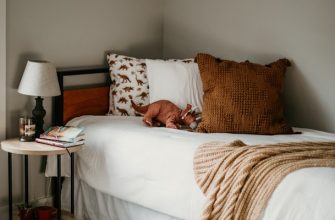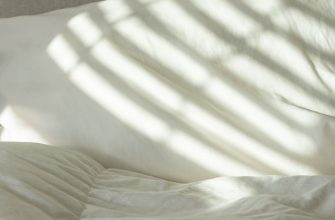- Creating a Sleep-Friendly Atmosphere: Key Environmental Factors
- The Role of Light and Darkness in Regulating Sleep Patterns
- Soundscapes and Sleep: How Noise Levels Affect Restfulness
- Temperature Control: Finding the Ideal Sleep Environment
- The Importance of Clean Air: How Indoor Pollution Impacts Sleep Quality
- Designing Your Bedroom for Better Sleep: Tips and Tricks
Creating a Sleep-Friendly Atmosphere: Key Environmental Factors
Creating a sleep-friendly atmosphere is essential for combating insomnia. Various environmental factors significantly influence sleep quality and can either promote restful sleep or contribute to disturbances. Understanding these factors is crucial for those seeking to enhance their sleep environment.
- Lighting: Dim lighting in the evening signals the body that it’s time to wind down. Exposure to bright lights, particularly blue light from screens, can interfere with the production of melatonin, a hormone responsible for regulating sleep.
- Temperature: Maintaining a comfortable bedroom temperature is vital for promoting sleep. Ideally, a cooler room encourages deeper sleep, while excessive heat can lead to restlessness during the night.
- Noise Levels: A quiet environment contributes to better sleep quality. Sounds such as traffic or loud neighbors can disrupt the sleep cycle, making it difficult to fall asleep or stay asleep throughout the night.
- Air Quality: Fresh air circulation is important for a restful night’s sleep. Poor air quality can lead to discomfort and wakefulness, so ensuring proper ventilation and humidity levels can enhance the overall sleep experience.
- Bedding and Comfort: The right mattress and pillows play a critical role in sleep comfort. Choosing supportive bedding that caters to individual preferences can significantly improve sleep quality and reduce insomnia symptoms.
Incorporating these environmental factors into a nightly routine can create a sleep-friendly atmosphere, ultimately helping to combat insomnia. By paying attention to lighting, temperature, noise levels, air quality, and bedding, individuals can foster an environment conducive to restful and restorative sleep.
The Role of Light and Darkness in Regulating Sleep Patterns
Light and darkness play a crucial role in regulating sleep patterns, significantly influencing the quality of rest and overall well-being. Exposure to natural light during the day helps to maintain a healthy circadian rhythm, which is vital for a good night’s sleep. When light enters the eyes, it signals the brain to produce hormones that promote alertness, thereby impacting sleep quality at night.
Conversely, darkness triggers the production of melatonin, the hormone responsible for inducing sleepiness. This natural process highlights the importance of minimizing light exposure before bedtime. Creating a dark environment can enhance melatonin production, leading to improved sleep quality.
- Natural light exposure during the day boosts mood and energy levels.
- Artificial light at night can interfere with melatonin production.
- Blue light emitted from screens is particularly disruptive to sleep patterns.
- Using blackout curtains can help create a dark sleep environment.
- Light therapy can be beneficial for those with sleep disorders.
Incorporating strategies to manage light exposure can be an effective way to combat insomnia. It is essential to establish a sleep-friendly environment by dimming lights in the evening and avoiding screens at least an hour before sleep. Additionally, exposure to natural sunlight during the day can help reinforce a healthy sleep-wake cycle.
By understanding the impact of light and darkness on sleep, individuals can take proactive steps to enhance their sleep quality. Prioritizing a dark, quiet, and comfortable sleeping environment is vital for overcoming insomnia and achieving restorative sleep.
Soundscapes and Sleep: How Noise Levels Affect Restfulness
Soundscapes play a crucial role in determining sleep quality. Various noise levels can either promote relaxation or hinder the ability to fall asleep. Understanding how sound impacts restfulness is essential for combating insomnia effectively.
Different types of noise can create varying environments that influence sleep. For instance, white noise can mask disruptive sounds, providing a consistent auditory backdrop that many find soothing. Conversely, loud or abrupt noises can interrupt the sleep cycle, leading to fragmented rest and increased insomnia symptoms.
- Natural Sounds: Gentle rain, ocean waves, and rustling leaves are known to create calming environments that enhance sleep quality.
- White Noise: This sound can help mask sudden interruptions, making it easier to maintain a deeper sleep state.
- Music for Relaxation: Soft melodies or specific frequencies can lower stress levels and promote a more restful sleep.
- Silence: In some cases, a completely quiet environment can be most beneficial, allowing the mind to settle and transition into sleep.
Research indicates that exposure to consistent and soothing soundscapes can lead to improved sleep duration and quality. Implementing sound-based strategies can be a simple yet effective way to fight insomnia. By creating a sleep-friendly environment, individuals can enhance their chances of achieving restful and restorative sleep.
In conclusion, the impact of noise levels on sleep cannot be underestimated. By carefully selecting soundscapes that promote relaxation, individuals can significantly improve their sleep experience. Whether through natural sounds, white noise, or calming music, the right auditory environment is key to reducing insomnia and enhancing overall sleep quality.
Temperature Control: Finding the Ideal Sleep Environment
Temperature control plays a crucial role in creating an ideal sleep environment. Maintaining the right temperature in the bedroom can significantly impact the quality of sleep and help combat insomnia. The optimal sleeping temperature is generally considered to be between 60 to 67 degrees Fahrenheit (15 to 19 degrees Celsius). This range allows the body to lower its core temperature, which is essential for inducing sleep.
When the bedroom is too warm, it can lead to discomfort and restlessness, making it difficult to fall asleep and stay asleep. Conversely, a room that is too cold can also disrupt sleep patterns, causing frequent awakenings. Therefore, finding the right balance is essential for a restful night.
- Use a programmable thermostat: This allows for precise temperature adjustments throughout the night, ensuring a comfortable sleep environment.
- Choose breathable bedding: Natural fabrics such as cotton and linen can help regulate body temperature and wick away moisture.
- Consider cooling mattresses: Some mattresses are designed with cooling technology that helps dissipate heat and maintain a comfortable sleeping temperature.
- Ventilation is key: Proper airflow can help keep the bedroom cool; opening windows or using fans can improve comfort levels.
- Avoid electronics: Devices that emit heat, such as televisions and computers, should be kept out of the sleeping area to maintain a stable temperature.
In addition to temperature, other environmental factors such as noise, light, and humidity can also influence sleep quality. It is essential to create a holistic sleep environment that addresses all aspects, including temperature control. By prioritizing the right temperature, individuals can enhance their ability to fall asleep and reduce the impact of insomnia.
The Importance of Clean Air: How Indoor Pollution Impacts Sleep Quality
Clean air is crucial for overall health, yet many individuals underestimate the impact of indoor pollution on sleep quality. Poor air quality can lead to various health issues, including respiratory problems and sleep disturbances. By understanding how indoor air pollution affects rest, individuals can take actionable steps to improve their sleeping environment.
Indoor pollution sources often include household products, building materials, and even outdoor air that infiltrates homes. These pollutants can include volatile organic compounds (VOCs), dust, mold, and allergens, all of which can contribute to a restless night. Enhanced awareness of these factors is essential for anyone struggling with insomnia or seeking better sleep quality.
- Volatile Organic Compounds (VOCs): These chemicals can be emitted from paints, cleaning supplies, and furniture, leading to discomfort during sleep.
- Dust and Allergens: Accumulation of dust mites, pet dander, and pollen can trigger allergic reactions, making it difficult to achieve restful sleep.
- Mold: This can grow in damp areas of the home, releasing spores that can irritate the respiratory system and disrupt sleep patterns.
Improving indoor air quality is vital for promoting restful sleep. Simple actions can significantly enhance the sleeping environment. Regular cleaning to minimize dust accumulation, using air purifiers to filter pollutants, and ensuring proper ventilation can all play a role in creating a healthier atmosphere. Additionally, selecting low-VOC products can reduce harmful emissions, further contributing to a peaceful night’s rest.
In conclusion, recognizing the importance of clean air is essential for anyone seeking to combat insomnia. By actively addressing indoor pollution, individuals can foster an environment conducive to quality sleep, ultimately enhancing overall well-being.
Designing Your Bedroom for Better Sleep: Tips and Tricks
Creating a serene environment is essential for achieving restful sleep. The design of a bedroom plays a significant role in how well one sleeps. A well-thought-out bedroom design can significantly reduce insomnia and enhance overall sleep quality. Here are some effective tips and tricks for designing a bedroom that promotes better sleep.
- Color Scheme: Opt for calming colors such as soft blues, greens, or neutral tones. These shades create a peaceful ambiance that encourages relaxation.
- Lighting: Utilize adjustable lighting options. Soft, dimmable lights can help signal to the body that it’s time to wind down. Consider blackout curtains to block out external light.
- Furniture Arrangement: Arrange furniture to create a sense of openness. Avoid clutter and ensure that pathways are clear to foster a tranquil atmosphere.
- Bedding Choices: Invest in high-quality mattresses and pillows that provide adequate support. Natural fabrics like cotton or linen can enhance comfort and breathability.
- Temperature Control: Maintain a cool room temperature, ideally between 60-67°F (15-19°C), to promote better sleep. A fan or air conditioning unit can help regulate temperature effectively.
- Minimize Noise: Soundproof the room by using thick rugs, curtains, or sound machines. These elements can help mask disruptive noises that interfere with sleep.
- Personal Touches: Incorporate elements that evoke tranquility, such as plants or artwork that inspires calmness. Avoid busy or overwhelming designs that can distract the mind.
Incorporating these elements into bedroom design can lead to a more restful environment, ultimately combating insomnia. A thoughtfully designed space not only enhances sleep quality but also contributes to overall well-being. Prioritizing comfort and tranquility within the bedroom is a crucial step toward achieving better sleep and reducing the impact of insomnia.








